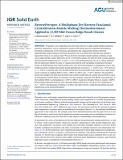ReversePetrogen: A Multiphase Dry Reverse Fractional Crystallization‐Mantle Melting Thermobarometer Applied to 13,589 Mid‐Ocean Ridge Basalt Glasses
Author(s)
Brown Krein, S.; Molitor, Z. J.; Grove, T. L.
DownloadPublished version (5.199Mb)
Publisher Policy
Publisher Policy
Article is made available in accordance with the publisher's policy and may be subject to US copyright law. Please refer to the publisher's site for terms of use.
Terms of use
Metadata
Show full item recordAbstract
We present a new algorithm, ReversePetrogen (RevPet), to infer mantle melting conditions (pressure, temperature, source composition) using evolved basalts that have experienced multiphase fractional crystallization. RevPet measures and minimizes the compositional distance between experimentally predicted phase saturation boundaries and an erupted basalt and the more primitive liquids that return it to a primary melt. We use RevPet to investigate mantle melting conditions at mid-ocean ridges (MORs) using a global data set of 13,589 basaltic glasses. We find that their average apparent mantle potential temperature (TP*) is 1322°C ± 56°C with melting pressures of 13.0 ± 5 kbars. Inferring the true initial (pre-melted) TP from TP* requires knowing the style and degree of melting of the input basalts. If MORB glasses were entirely produced by near-fractional melting of a homogenous source, they would record the cooling of the mantle during melting from an initial TP = ∼1380°C (ΔTP = 0°C) down to TP = ∼1270°C. If, instead, they were all fully pooled near-fractional melts of the same source, they would record variations in ambient MOR TP from ∼1300°C to 1450°C (ΔTP = 150°C). However, because MOR basalts are thought to be both near-fractional and variably pooled melts of variable sources, MOR TP must be intermediate between these two extremes. Our best estimate, consistent with MOR crustal thickness, is that ambient MOR TP is homogenous (∼1350°C–1400°C) except near hotspots where TP reaches ∼1600°C. Some primitive glasses found near slow-spreading ridges and back-arcs record very low temperatures (TP* < 1250°C) and pressures of melting (<10 kbar) and reflect mantle cooling during melting and melt equilibration in the mantle lithosphere.
Date issued
2021-07Department
Massachusetts Institute of Technology. Department of Earth, Atmospheric, and Planetary SciencesJournal
Journal of Geophysical Research: Solid Earth
Publisher
American Geophysical Union (AGU)
Citation
Brown Krein, S. et al. "ReversePetrogen: A Multiphase Dry Reverse Fractional Crystallization‐Mantle Melting Thermobarometer Applied to 13,589 Mid‐Ocean Ridge Basalt Glasses." Journal of Geophysical Research: Solid Earth 126, 8 (August 2021): e2020JB021292. © 2021 American Geophysical Union
Version: Final published version
ISSN
2169-9313
2169-9356